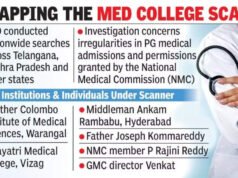Hyderabad: Telangana lacks a comprehensive disaster response framework that includes animal rescue and protection, animal husbandry minister Vakiti Srihari said on Thursday. But that can be changed soon, he felt.Speaking at Telangana’s first conference on animal-inclusive disaster risk reduction, Srihari said experts would be engaged to help the disaster response team develop an animal-focused evacuation and safeguarding plan, which will be placed for cabinet approval.HYDRAA commissioner A V Ranganath emphasised the need to train disaster response teams, farmers and breeders and to map livestock populations across the state to enable swift rescue operations during emergencies. “We are not even aware where most of these livestock are concentrated. In Hyderabad, there are certain markets where poultry is concentrated — and on the outskirts where agriculture is located. We can draw a holistic plan once we map them,” he said.The event, organised by UNICEF and Humane World for Animals India, aimed to integrate animal welfare into the state’s disaster preparedness and response mechanisms. It brought policymakers, disaster management authorities and sector specialists together to examine how Telangana’s floods, heatwaves, droughts and cyclones continue to endanger more than 35 million farmed animals. This directly affects livelihoods of millions of families, too.Erratic climate patterns make disaster response increasingly unpredictable, the HYDRAA commissioner said, highlighting the need to strengthen early weather warning systems for farmers. “Improved alerts would help them shift their livestock to safer areas or elevated plains ahead of floods or extreme weather. This can be done by increasing the number of Automated Weather Systems. We now have around 156 — but this should be increased,” Ranganath said.Speakers also proposed creating dedicated shelters for animals to ensure safe evacuation during disasters. Sekhar L Kuriakose, Kerala State Disaster Management Authority member secretary, highlighted how a permanent emergency evacuation shelter in Wayanad, an area frequently affected by weather extremes, played a crucial role in protecting animal lives.“It’s a risk-resilient structure designed to sustain animals during emergencies. It has adequate provisions for feeding and water, sufficient space for both small and large animals, proper grazing areas, ventilation and light. It includes a sewage treatment, and a biogas, plant for waste management. Telangana can follow this model,” Kuriakose said.







